Ibike Korea People-to-People Program
 Photo essay: Hoeyang
(and Uiryeong) to
Jinju
Photo essay: Hoeyang
(and Uiryeong) to
Jinju
Hoeyang to Jinju (40mi, 65km) Jinju is a gem of a
city, rich in culture and history.
Uiryeong to Jinju (31mi, 50km) A signed bike route roughly follows the Namgang
(South River).
The ride is as good as a slide show -- every corner seems to beg another picture or two:
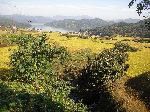
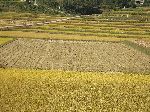
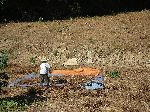
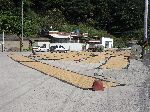
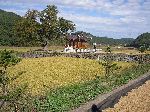
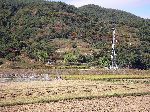
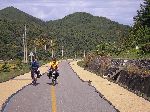
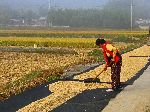 Nammyeong
Road is a very low volume road. There
is rice laid out to dry on both sides of the road, and no tire tracks through it
-- click.
Nammyeong
Road is a very low volume road. There
is rice laid out to dry on both sides of the road, and no tire tracks through it
-- click.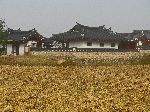
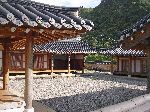 Yongeon-sa was originally begun in
1580. Sancheonggun has a long history. The famous Confucian scholar
of the middle Joseon Dynasty, Master Nammyeong (1501-1572), was born, studied,
and taught in this area -- click.
Yongeon-sa was originally begun in
1580. Sancheonggun has a long history. The famous Confucian scholar
of the middle Joseon Dynasty, Master Nammyeong (1501-1572), was born, studied,
and taught in this area -- click.
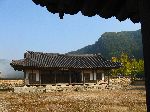 Several of the historic buildings in
the area are being restored [2005].
Several of the historic buildings in
the area are being restored [2005].The same buildings after the project was finished --click.
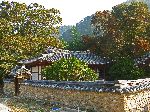
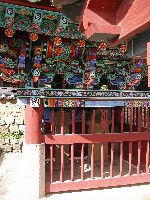
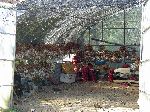
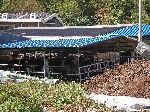 A shed full of garlic -- click.
A shed full of garlic -- click.Cows living their lives out in a shed -- click.
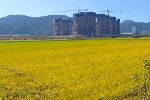
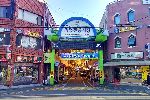 An
alternative way to approach Jinju is from Uiryeong, to the east, along a signed
bike route that generally follows the South River (Namgang).
An
alternative way to approach Jinju is from Uiryeong, to the east, along a signed
bike route that generally follows the South River (Namgang).Uiryeong is another village that is becoming high rise as new housing is built to the edge of the rice fields. But even as hardly more than a village, it has friendly citizens, significant historical features and a seemingly robust economy that includes a vibrant central market (right), shops to meet every need, multiple old spas/public baths, dozens of restaurants and almost as many yeogwans/hotels.
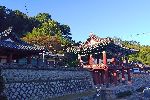
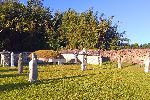 Just
off the center of town, Uiryeong Hyanggyo (left) was moved to this hillside
location in 1582. Its original date of construction is uncertain. The purpose of
hyanggyos was general education, the education of public mores, and the
performance of ceremonies dedicated to Confucian sages. The space inside the
hyanggyo was segregated into educational and ceremonial areas.
Just
off the center of town, Uiryeong Hyanggyo (left) was moved to this hillside
location in 1582. Its original date of construction is uncertain. The purpose of
hyanggyos was general education, the education of public mores, and the
performance of ceremonies dedicated to Confucian sages. The space inside the
hyanggyo was segregated into educational and ceremonial areas.Nearby is the tomb of Nam Gun-bo (right), that dates of the Goryeo Dynasty (born ~1186). He was a civil official. Seven generations earlier the Uiryeong Nam Ssi clan was naturalized from China.
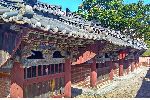
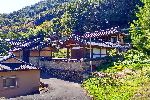 Chil
(7) jeongryeo (left) is a row of seven shrines from the Joseon period to educate
people on loyalty to the country, filial piety and heroic activities. These wood
and tile ryeo were constructed between 1712 and 1905 to commemorate
various people and events.
Chil
(7) jeongryeo (left) is a row of seven shrines from the Joseon period to educate
people on loyalty to the country, filial piety and heroic activities. These wood
and tile ryeo were constructed between 1712 and 1905 to commemorate
various people and events.
Deokgok seoweon (Confucian Academy) (right) was established in 1645. Seoweons had the combined functions of a Confucian shrine and a preparatory school. It was demolished after the order to close private schools, in 1871, and then restored and rebuild between 1902 and 2012.
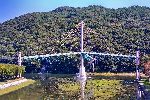
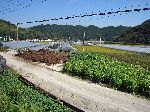
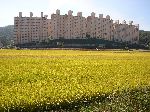
Into Jinju-si.
 Please
contact us if you would like to be added to
Ibike's mailing list or have questions, comments, corrections or criticism. (Also, please let us know how you learned about us and
found this site.) Privacy policy.
Please
contact us if you would like to be added to
Ibike's mailing list or have questions, comments, corrections or criticism. (Also, please let us know how you learned about us and
found this site.) Privacy policy.
![]() IBF Homepage
IBF Homepage ![]() Ibike Programs
Ibike Programs
![]() Ibike Schedule
Ibike Schedule
![]() Search
Search



